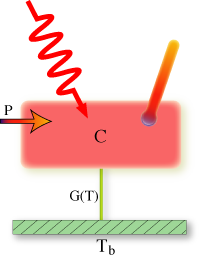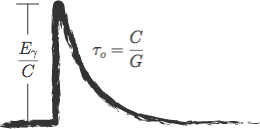The Ideal Microcalorimeter

To derive the response of a microcalorimeter to an incident photon, we start by looking at energy flow. The temperature of the absorber will depend on how energy goes in and how much goes out through the weak thermal link:To derive the response of a microcalorimeter to an incident photon, we start by looking at energy flow. The temperature is proportional to the power flowing through the detector:
Where C is the heat capacity of the absorber, T is the temperature of the absorber, P is some power dissipated in the absorber, G is the thermal conductance, Tb is the bath temperature and E is the energy of the photon incident at time t=0.
This equation can be readily solved for the temperature T assuming the Power P is a constant:
So the response to a photon is a single exponential decay from with a time constant τ = C/G and an amplitude proportional to the energy of the photon:

All we need is a good way to accurately measure the temperature of the absorber. In our lab we are developing two different technologies: transition-edge sensors and magnetic calorimeters. Both hold great promise to achieve very high resolutions (E/ΔE > 1000), and we are excited about the possibilities these technologies hold for future large-format detectors for both Earth and Space-borne applications.
